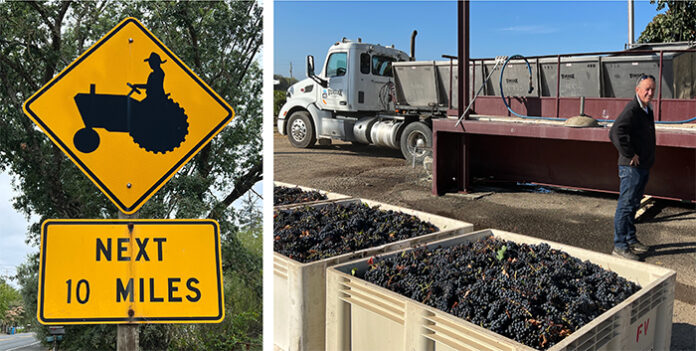
The traffic sign on Dry Creek Road reminds me farming takes place here every day. And, isn’t it glorious to live in an area that is grounded? Literally grounded, making a living from the earth.
If you’ve been on a local road behind a tractor with a train of rattling steel bins, seen nighttime klieg lights illuminating vineyards or passed flatbeds hauling grapes, it’s hard not to know harvest is in full swing. Harvest starts with champagne grapes and ends with cabernet. A typical progression might be: sauvignon blanc, chenin blanc, pinot grigio, chardonnay, pinot noir, merlot, zinfandel, cabernet franc, syrah, and lastly, cabernet sauvignon.
This year, some vintners picked champagne grapes, then cabs. Perhaps the ju-jitsu of temperatures—we had record highs at 112 degrees, lows at 48 the next week, and now rain—confused fruit maturation. Whatever the reason, harvesting ripe grapes has been a little more challenging this year.
Hat tip to Nick Goldschmitt, pictured above, who produces wine locally and consults the world over on better wine making, for the information on this year’s weather effects. Goldschmitt is pictured at Foppiano’s facility, where Rob McNeil does a great job as senior manager and winemaker.
Fun facts: Wine production in this area began in 1812 with Russian plantings on the coast. Italian immigrants came in the late 1800s, planting vines and passing down vineyards through generations. Their names and legacies, like Seghesio, Foppiano and many others, thrive over 100 years later.
In 1920, 256 wineries and 22,000 acres were in production in the county. During the 1940s, German POWs helped harvest. U-Boat crews were reportedly rough guys, while prisoners from Rommel’s desert army were said to be friendlier.
Today, the Dry Creek AVA, 16 miles long and two miles wide, has over 60 wineries and 150 grape growers. An AVA (American Viticultural Area) is a government designated wine growing region. Dry Creek AVA is known for zinfandels, one of the oldest varietals in the world, dating from 6,000 BC in Croatia.







